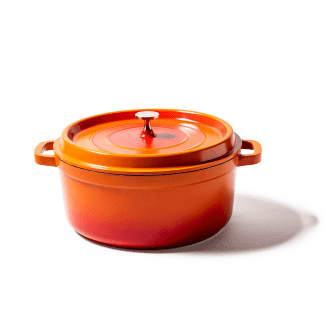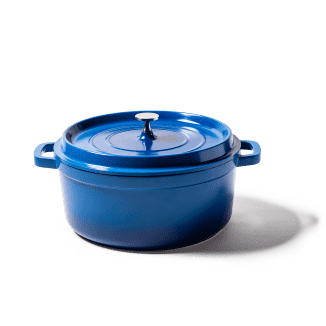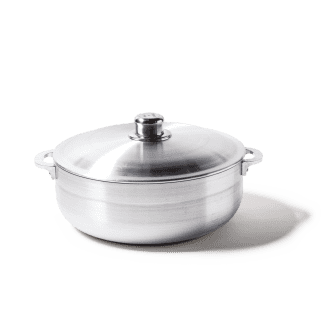The best cast-iron Dutch ovens do it all, but they’re too heavy for some cooks. We tested lighter-weight options to find an alternative that was just as versatile and dependable. None had the excellent heat retention of a cast-iron Dutch oven (which is essential for baking bread), but some lightweight models shined in other ways. They heated evenly, which is essential for a great sear, and they excelled when used for braising, frying, and making rice. In the end, a stainless-steel model won out as the best lightweight option: We recommend the All-Clad D3 Stainless Stockpot with Lid, 6 Quart for its even heat distribution; wide cooking surface; comparatively low sides; large, sturdy handles; and durability.

We love traditional Dutch ovens because of how versatile they are. We stock dozens of our top-rated models in the test kitchen, routinely using them to boil, braise, bake, fry, and more. Most Dutch ovens are made from enameled cast iron, and they’re quite heavy—we’ve tested options that weigh more than 18 pounds. In most cases this heft is helpful: Heavy cast iron retains heat well, which makes it ideal for baking picture-perfect, crusty loaves of bread as well as deep frying. It’s also great for searing and braising meat and making soups and stews. But cast-iron cookware can be too heavy for some home cooks, especially those with disabilities, arthritis, or otherwise diminished hand, arm, or back strength. So we set out to find a lightweight pot that is just as versatile and dependable as a cast-iron Dutch oven but doesn’t sacrifice quality for lightness.
Our research led us to conclude that there aren’t many criteria a pot has to follow to be dubbed a Dutch oven. Manufacturers throw the label on pots made from any material you can think of, from cast iron to stainless steel, aluminum, and even ceramic. Many have enameled or nonstick coatings. Some products are labeled “stockpots” or “casseroles'' as well as or instead of being called a Dutch oven. For this review, we focused less on name and more on certain characteristics. We selected pots made from stainless steel and aluminum, with sides no higher than 6 inches, since higher sides can keep cooks from being able to reach and manipulate food. We focused on models that held from 6 to 7 quarts—the size we call for in most of our recipes—and that weighed less than 6.5 pounds, which is far less heavy than our cast-iron winner.

The lightweight options we tested were easier to handle and maneuver than heavy cast-iron pots. Some seared meat as evenly and quickly as cast-iron pots. But what we gained in maneuverability, we lost in heat retention. The lightweight models couldn’t radiate enough heat to produce crusty, well-browned loaves of bread. Some were also unable to successfully trap steam and moisture, which is also necessary for bread baking, as well as braising. We still suggest using a cast-iron Dutch oven for baking bread, but the lightweight options we found are versatile enough to sear, braise, and fry, and we recommend them for people who prefer a lighter pot.
What To Look For
- Large Capacity: Our favorites were big enough for deep frying or for preparing large batches of soups, stews, or braises. We think a capacity from 6 to 7 quarts is good for an all-purpose model.

- Fully Clad Stainless Steel: The best pots were stainless-steel “tri-ply,” which means that they’re made with three layers of metal: a highly conductive aluminum core sandwiched between layers of durable stainless steel. They’re also fully clad, meaning that these three layers run through every part of the pot, from the bottom to the rim. These pots heated up fast, retained heat well, and distributed it evenly, making for a great sear without hot spots. Lots of fond formed, which was great for building complex, rich sauces during braises. In addition, their light-metal interiors let us monitor browning easily.
- Large, Easy-to-Grip Handles: Large, sturdy handles that stuck out allowed us to hold on to the pots securely when we carried them or maneuvered them into or out of the oven, even while wearing oven mitts.
- Wide Cooking Surface: The more space you have to cook, the more food you can cook at once. We liked pots with 9-inch-wide or larger cooking surfaces, which allowed us to brown meat in fewer batches and in less time.
- Straight Sides: We preferred straight sides that provided a clear distinction between the walls and the cooking surface, which maximizes cooking space.

What To Avoid
- All-Aluminum Pots: Aluminum is an excellent heat conductor, but pots made completely from aluminum were more likely to heat unevenly and develop hot spots.
- Dark Interiors: Pots with dark interiors prevented us from seeing how quickly food was cooking or browning as well as how much fond was accumulating.


- Lids with Gaps or Holes: Holes or gaps designed to make draining easier or allow steam to escape did just that: allowed too much moisture to escape during braises, making for overreduced, thick sauces.
- Curved Sides: Curved sides take away valuable cooking space.
When shopping for a lightweight Dutch oven, focus less on terminology and more on size and shape. Look for a wide cooking surface and low-enough sides (between 4 and 6 inches) to maneuver food easily.
Other Considerations
- The Pros and Cons of Nonstick: We love nonstick cookware for cooking delicate foods that stick easily, such as eggs, stir-fries, and fish. Some of the pots in our lineup had nonstick coatings, but we found it harder to develop fond in them. Fond is important when searing or braising; the caramelized bits of food that accumulate provide the foundation for a complex sauce. If fond doesn’t form, you miss out on flavor. Still, some cooks prefer nonstick cookware because it’s easier to clean; this was true for the pots in our lineup.
The Tests
- Boil water, timing how long it takes to bring the water to a boil
- Make White Rice
- Make Beef Burgundy
- Wash 10 times with an abrasive sponge
- Whack the rim 50 times with a metal spoon
- Slam the lid onto the pot 25 times
- Winner only: Fry french fries and bake Almost No-Knead Bread
How We Rated
- Cooking: We tested how well the pots could make rice and sear and braise meat, as well as how long it took them to boil water.
- Ease of Use: We evaluated the pots on how easy they were to cook in, clean, and move around.
- Durability: We tested how well the pots held up to repeated use and abuse.

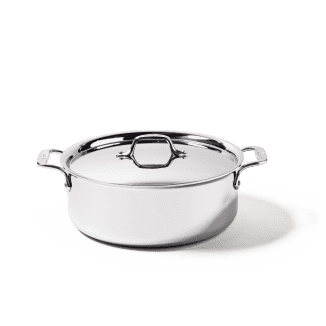






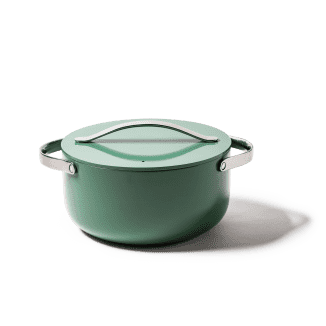
 Buy at Target
Buy at Target